14 March, 2000
Wildlife at the dive site
Question 24: What kingdom and phylum of organisms do sea stars belong to?
Today I was going to write about the bioassays that are being carried out,
but our dive group got to do a SEAL team-style shore retrieval of two divers
and had lots of other excitement so the bioassay discussion will have to wait.
We started out with thick fog this morning. I could see blue sky above and
the rays of sun trying to come through, but not much else was visible. Around
lunch the fog started clearing out, so we went ahead and got suited up for a
dive. Jim and I tended for Katrin, Ross, Chuck, and Bill. There was still
enough fog that we had to navigate to Janus Island using a compass and GPS
rather than sight.
This location is a wall dive. The water depth goes from 30 ft to over 100 ft
in less than 20 horizontal feet and continues down from there. This means we
do live boating. We do not anchor, but instead drop divers into the water and
then pull the boat off the dive site to watch the area. When they return to
the surface, we motor in to pick them up. There was quite a bit of current at
the surface as well as at depth so we all had to be on our toes to make sure
everything went smoothly. We put each pair of divers in at the same site,
approximately 15 minutes apart.
Once they were down, we watched for wildlife and adjusted the boat's position
whenever we drifted too far away. The island itself has one of the largest
groups of Adelie penguins that I have seen in the area. It is past their
breeding season and the majority have departed into the ocean. One zipped
past and under our boat as we were getting the divers ready, but most of them
were hanging out on shore.
After the divers were down, we spotted a group of six large seals coming
along the coast. The two animals we are concerned about on a dive are Leopard
Seals and Orcas. Sighting either of those means we call the divers back to
the surface. So, large seals are something we always check out. Since there
was a group of them it was unlikely that they were Leopards. They turned out
to be Crabeater seals. They cruised along the shoreline together, making
several long dives. The weather was clearing slowly, and by the time our
first two divers surfaced there was only blue sky.
When Chuck and Ross surfaced and were picked up, they were jazzed! The wall
was incredible, covered with all sorts of algae and sponges, and the Crabeater
seals had come to visit them down around 100 ft! They were telling us about
it when we saw our other two divers pop up close to shore and ahead of
schedule. When they started clambering up on shore we knew something was
wrong. Then we spotted the Leopard seal cruising back and forth in the water
within 5 feet of them! There has never been a documented case where a Leopard
seal has harmed a diver, but that doesn't mean they haven't come close, and we
don't want to be the first. We rushed the boat over to where Katrin and Bill
were hauled out on the rocks. The seal stopped circling so close after we
were snugged up to shore for several minutes.
The wave action made the retrieval much more difficult. The crashing surf
took our boat up and down more than five feet every few seconds as we were
trying to transfer gear and divers. We pushed the bow of the Zodiac up to the
rock and had tenders sitting on the tubes to help the divers. Katrin was
pulled off the rocks and we had to back out into the water to get her gear off
and drag her into the boat. It wasn't great so we tried a variation to get
Bill. Chuck, still in his drysuit, was put ashore to help Bill remove his
gear. Then we nosed the bow up to the rocks again and Katrin and I sat on the
very front of the boat to take tank, bc, collection bag, fins, and finally
Bill and Chuck into the boat. It wasn't pretty but it worked.
Just as we had collected everything and everyone into the boat, there was a
huge splash right near us. The Leopard seal had cleared most of his body out
of the water with a huge jump. He made another one almost as big and came up
with a penguin! We pulled away from shore but didn't leave the area. As
scientists, we shouldn't anthropomorphize an animal's behavior (assign
human-like thoughts and feelings to his actions), but the Leopard seal spent
the next 20 minutes toying with the penguin within four to 30 feet of our boat
as if trying to impress us. It worked, we were very impressed!!!! While
unpleasant for the Gentoo penguin, the 12 foot seal demonstrated incredible
agility and swiftness in the water while letting the penguin go and
recapturing it. It was an incredible event to see and be so close to a
feeding Leopard seal. Very unusual. It was directly under the boat at
several points. Eventually, the seal started to eat in earnest and
disappeared from view, and I drove the group back to the station.
With the slow "shutter" time of the digital camera, I didn't get any stellar
pictures, but I am including a few anyway so everyone can at least see
something of the event. Later in the beautiful day, Bruce and I went across
on the trolley to Bonaparte Point. But that will have to wait for another
journal entry!
Answer 23: It may resemble a football huddle, but doesn't act like one! A
"huddle" is a group of male Emperor penguins crowded together for protection
from the cold and wind of mid-winter. The birds on the windy side gradually
move along the side
(all the time balancing the precious egg on their feet) and reach the shelter
of the opposite side. These birds are enclosed by new arrivals from the windy
side and gradually they are in the center and eventually on the windy outside
again. Thus the huddle moves downwind, and each individual penguin bears a
share of the extreme environment.
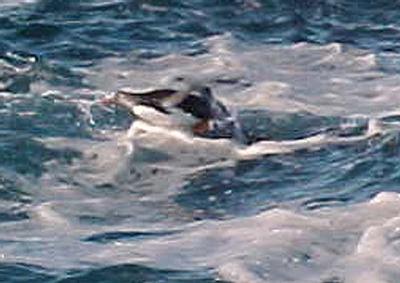
Gentoo in Leopard seal's mouth.
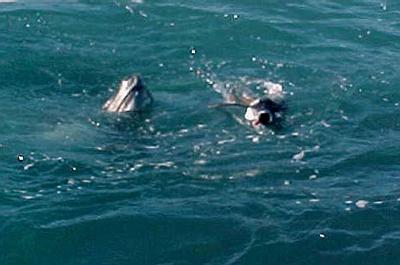
Leopard seal muzzle and Gentoo penguin.

Leopard seal chasing Gentoo underwater.
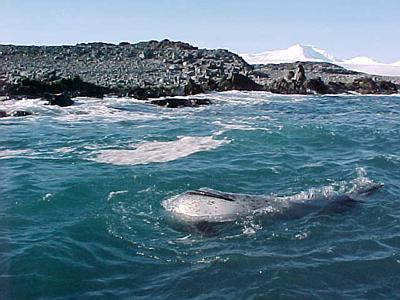
Leopard seal by dive boat off of Janus Is.
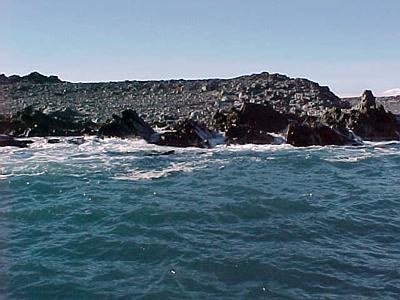
Practice your seal spotting skills: Can you find the Leopard seal?
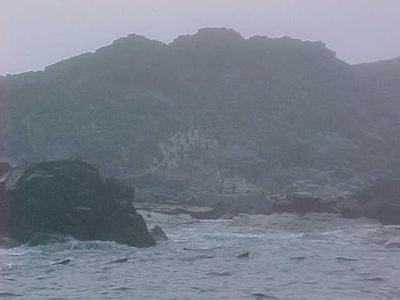
Practice your seal spotting skills: Can you find the Crabeater seals?

Katrin, Chuck and Jim getting ready for the dive off of Janus Island.

Contact the TEA in the field at
.
If you cannot connect through your browser, copy the
TEA's e-mail address in the "To:" line of
your favorite e-mail package.
|
